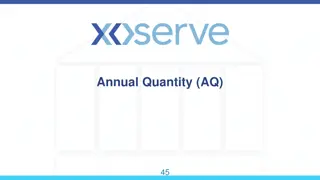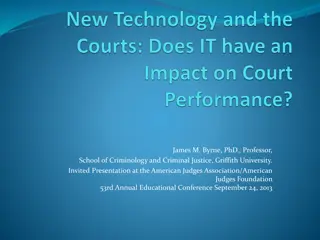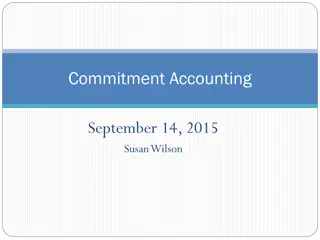Technological Innovations in Institutional Corrections Overview
The presentation provides insights into technological innovations in institutional corrections, focusing on the USA's incarceration rates, demographic patterns, new state prison admissions, official views on prison violence, and the new technology of inmate classification. It highlights the significance of classification decisions in managing violence and disorder within prisons amid a high inmate population. The data sheds light on key aspects of the criminal justice system, including prison demographics, crime profiles, and the global context of incarceration.
Download Presentation

Please find below an Image/Link to download the presentation.
The content on the website is provided AS IS for your information and personal use only. It may not be sold, licensed, or shared on other websites without obtaining consent from the author.If you encounter any issues during the download, it is possible that the publisher has removed the file from their server.
You are allowed to download the files provided on this website for personal or commercial use, subject to the condition that they are used lawfully. All files are the property of their respective owners.
The content on the website is provided AS IS for your information and personal use only. It may not be sold, licensed, or shared on other websites without obtaining consent from the author.
E N D
Presentation Transcript
Technological Innovations in Institutional Corrections James Byrne University of Massachusetts Lowell April 16,2015
USA and Mass Incarceration Incarceration Rates: 10-15 times higher than other developed countries Who goes to prison in USA: 1,574,700 in federal and state prisons in 2013; minority over-representation( blacks 16% of pop but about half of all state prisoners; Hispanics are fastest growing group of federal prisoners Federal Prisoner Crime Conviction Profile: 6/10 drug State Prisoner Crime Conviction Profile: about half are convicted for violent crime; 30% drug, 20% property, gun, public order Global Context: 1in 3 women incarcerated globally are in USA prisons; USA has 5% of world pop., but 25% of all prisoners are in USA prisons
A Profile of new state prison admissions in 2009 482,000 new admissions( new convictions and technical violators) 27% Violent offenders( murder, rape, robbery , assault) 29% property offenders 28% drug offenders 14.5% public order offenders
Official View of Prison Violence in USA Death in prison: illness, homicide, suicide, and deaths from unknown causes 3,175 deaths in prison in 2000; 3,351 in 2012 2,402 illness/natural causes in 2000; 2,953 in 2012( 88% of all deaths, with over half age 55+) 302 AIDS in 2000 vs 74 in 2012 198 Suicide in 2000 vs 205 in 2012 56 Homicide in 2000 vs 85 in 2012 217 other causes: executions, accidents, drug overdoses in 2000 vs 26 in 2012
The New Technology of Inmate Classification Size of Prison Population: With over 2.5 million inmates currently under institutional control in this country, it is clear that imprisonment is viewed as an appropriate sanction for individuals convicted of a variety of crimes (violent, drug, property, public order). Number of Prisons: To efficiently impose this sanction, the U.S. currently has over 5000 adult prison and jails, each with its own unique design features, staffing ratios, design and operational capacity, offender population characteristics, and resource level. Classification: In each of these facilities, classification decisions are made that directly affect the level of violence and disorder in prison.
External Classification Systems Objective external classification systems are currently used by all federal and state prison systems in this country to determine the initial level of security/ control needed over the incoming prisoner population. Based on the offender s overall assessment score he/she is assigned to a minimum, medium, maximum, or super- max prison facility.
How do we classify prisoners? We look at the following factors: The seriousness of the commitment offense, sentence length, The offender s criminal history, Escape history, Prior incarceration history, Special monitoring needs (due to security threat assessment, gang affiliation, potential victimization, etc.),
Initial Prisoner Location Decisions We can learn a great deal about a prison system by closely examining how and why inmate location decisions are made. According to a recent nationwide review of prison classification systems conducted by Austin and McGinnis (2004), approximately 80 percent of the current federal and state prison population are identified as being appropriate for location in the general prison population; These inmates are placed in minimum (35%), medium (35%) and maximum security facilities (10%; about 1% in super-max facilities)
Special Prison Populations Approximately 15% of all inmates are classified (or reclassified) as special populations requiring separate housing away from the general population of prisoners; These inmates are placed in administrative segregation (6%), protective custody (2%), and facilities designed specifically for inmates with severe mental health (2%) or medical problems (2%).
Recent Trends in Special Populations: Segregation Units Use of Segregation Units has Increased: The percentage of inmates placed in administrative and disciplinary segregation has risen 40 percent nationally between 1995 and 2000; by comparison, the prison population increased by 28 percent during this same period . However, Use of Segregation varies by Location: a recent study of special population units noted that several states reported using segregation for less than 1 percent of the male and female inmate population (Maryland, New Hampshire, Ohio, and Vermont), while a few states placed a much larger percentage of inmates in segregation (West Virginia (16%), New Mexico (13%), and Colorado (8%)).
National Commission Recommendations on Use of Segregation 1. Make segregation a last resort and a more productive form of confinement, and stop releasing people directly from segregation to the streets. 2. End conditions of isolation. 3. Protect mentally ill prisoners
Recent Trends in Special Populations: Mental Health Units There is Variation in the percentage of inmates assigned to mental health units: Several states housed less than 1 percent of their male and female inmate populations in mental health units( Florida, Indiana, Missouri, New York, Oregon, Pennsylvania, Vermont), However, two states ( Georgia,12 %, and Alaska,5%) take a very different approach to the housing of mentally ill inmates.
State-Level Variations in External Classification Decisions In some prison systems (e.g. Rhode Island), only a small proportion (less than 5%) of all inmates are housed in one of these special population units; In other State Prison systems (e.g. Massachusetts), a much larger proportion (close to 40%) of all inmates are placed in these locations.
Why do State Prison Systems Vary in the Use of Special Population Housing? Philosophy: It should be emphasized that the size of a particular state s special population system is driven not by inmate characteristics and classification criteria alone; it represents a policy choice by corrections managers in each system. Cost: Since it costs much more to house offenders in special population groupings than in general population groupings, it is not surprising that some corrections systems limit the size of the special population system by narrowly defining the criteria used to make this initial classification decision.
Maximum Security Inmates It probably doesn t come as a surprise that an inmate placed in a maximum security facility in one state (or federal) system, may be placed in a different security level facility somewhere else. In fact, many general population prisoners classified as maximum custody do not present management problems and are so classified because of the crime they committed, their prison sentence, or a violent event that occurred many years in the past . Factors (e.g. punishment) other than risk control (or risk reduction) are driving the initial assignment process in many state and federal prisons today.
Internal Classification Systems: Assessment Areas In order to make prisons safer, a variety of assessment instruments are used to classify inmates in each of the following areas: (1) Threat/dangerousness, (2) Mental health/ potential for victimization and self-injury, (3) Physical health, (4) Treatment/programming needs, and (5) Escape/ flight risk.
AREA 1: Dangerousness and Threat Assessment There are a number of different risk assessment instruments currently in use across the country. Some instruments focus on specific forms of violence (e.g. the Rapid Risk Assessment for Sexual Offense Recidivism (RRASOR), the Sexual Violence Risk-20(SVR-20), and the Static-99, target sex offending), Other instruments assess an individual s general propensity for violent/assaultive behavior(eg. the Hare Psychopathy Checklist-Revised (PCL-R)).
Problems Related to Dangerousness Assessment The main problem associated with using the latest generation of risk assessment tools in prison settings is that these instruments were developed and validated using subsequent offender behavior in the community as the outcome measure of interest; They have not been developed and tested using institutional violence as the criterion/outcome measure.
Problems Related to Dangerousness Assessment Because the base rate of various forms of institutional violence is very low, it is likely that current risk instruments when validated will have difficulty distinguishing dangerous from non-dangerous inmates. This creates two potential problems for corrections managers: false positives, i.e. individuals predicted to be violent who actually do not become violent while in prison; and false negatives, i.e. individuals predicted to be non- dangerous who do in fact commit a violent act while in prison.
How to Reduce Prison Violence: Recommendations of National Commission 1. Reduce crowding. States and localities must commit to eliminating the crowded conditions that exist in many of the country s prisons and jails and work with corrections administrators to set and meet reasonable limits on the number of prisoners that facilities can safely house. 2. Promote productivity and rehabilitation. Invest in programs that are proven to reduce violence and to change behavior over the long term. 3. Use objective classification and direct supervision. Incorporate violence prevention in every facility s fundamental classification and supervision procedures. 4. Use force, non-lethal weaponry, and restraints only as a last resort. Dramatically reduce the use of non-lethal weapons, restraints, and physical force by using non-forceful responses whenever possible, restricting the use of weaponry to qualified staff, and eliminating the use of restraints except when necessary to prevent serious injury to self or others. 5. Employ surveillance technology. Make good use of recording surveillance cameras to monitor the correctional environment. 6. Support community and family bonds. Reexamine where prisons are located and where prisoners are assigned, encourage visitation, and implement phone call reform.
Threat Assessment in Prison Gang Members: While almost 90% of all prisons screen for gang/security threat group membership, there is significant variation in the percentage of the inmate population (male and female) actually identified as gang/STG members. Extent of Gang Membership Varies: In some states, such as Wisconsin (43%), New Mexico (36%), and Minnesota (30%), a large proportion of the incoming inmate population is identified; but in several other prison systems the initial screening results in the identification of a much smaller proportion of the inmate population. In California and Michigan, for example, only 1% of the inmate population was classified as gang/STG members
Gang Membership: How is it Defined? Gang/ STG membership can be determined from a range of sources, including inmate interviews, official police and court records, and evidence of inmate tattoos identifying gang affiliation. In Florida s department of corrections, an inmate would be classified as a gang member if he/she met any two of the following criteria: Admits to criminal street gang membership; Is identified as a gang member by a parent/guardian; Is identified as a gang member by a documented reliable informant; Reside/frequents a gang's area, adopts their style of dress, hand signs, or tattoos, and associates with known gang members; Is identified as a gang member by an informant of previously untested reliability and such identification is corroborated by independent information; Was arrested more than once in the company of identified gang member for offenses which are consistent with usual criminal street gang activity; Is identified as a criminal street gang member by physical evidence such as photographs or other documentation; Was stopped in the company of known criminal street gang members four or more times.
Problems with Gang/ Security Threat Assessment A number of recent reviews have indicated that the influence of gangs on both community and institutional violence and disorder has been exaggerated (Byrne and Hummer, in press; Byrne, 2006). In addition, there is no current empirical evidence identifying a link between security threat group membership and prison violence . Despite this research shortfall, gang/STG status will likely result in placement in administrative segregation and/or location in a high security facility (maximum security or super max prison). In some prison systems, it may even affect offender location during the initial prison classification process or upon transfer to a new institution.
Johnson v California Decision In California, corrections authorities were until recently assigning inmates to racially segregated cells in order to prevent members of race-based gangs from turning on one another in two-man cells . In Johnson v. California, the Supreme Court declared this practice unconstitutional . According to Justice Sandra Day O Connor(2005), When government officers are permitted to use race as a proxy for gang membership and violence without demonstrating a compelling government interest and proving that their means are narrowly tailored, society as a whole suffers
Religion and Security Threat Group Membership: Suspect Communities Religious Conversion and Terrorism: One area of potential controversy is an upcoming initiative to improve our data collection (and information sharing) on both religious preferences and religious conversion in prison; this approach is based on the belief that prisoner radicalization may result in increased levels of domestic terrorism in this country over the next few years. Tracking Religion: Since it is estimated that over 70 percent of religious conversions in prison involve conversion to Islam, it appears that it is the identification and tracking of this group of converted inmates that will be the primary focus of this strategy, although radicalized right-wing Christian extremist groups are also identified( e.g. Aryan Nation)
AREA 2: Mental Health Assessment in Prison and Jail Nature of the Problem: A number of recent reviews of federal, state, and local prisons and jails in the United States have identified the classification, treatment, and control of the mentally ill offender as one of the most serious management problems facing prison officials today. Extent of the Problem: While estimates of the size of the mentally ill prison and jail populations vary by the type of assessment completed and the definition of mental illness used, there is general agreement that at minimum-- about one in five offenders entering our prison system today have a serious mental disorder
Types and Rates of Mental Illness among Prisoners Rate of schizophrenia or other psychotic disorders is three to five times greater among prisoners as compared to the U.S. population., while the rate of bipolar disorder is 1.5 to 3 times greater (NCCHC,2002). Conservatively, it is estimated that there are at least 350,000 mentally ill people in prison and jail on any given day , There are three times as many severely mentally ill individuals in prison than in psychiatric hospitals.
Impact of Mental Illness on Prison Management I agree with the conclusion of the National Commission on Safety and Abuse in America s Prisons: (1) it certainly appears that we have replaced yesterday s asylums with today s prisons; and (2) the result is not only needless suffering by the individuals who are under treated but safety problems those prisoners cause staff and other prisoners .
Mental Illness: The Gender Gap Women prisoners are far more likely than men to identify as having a mental illness (24% vs 16%) and, Among those who do identify as mentally ill, women are far more likely than men to report a history of sexual (59% vs. 15%)and physical abuse (68% vs. 27%). The American Psychiatric Association recommends developing treatment programs especially for women prisoners that can address their history of trauma
Area 3:Health Status of Prisoners: Disease Prevalence Compared to U.S. Population Infectious disease: Hepatitus C(4x greater), AIDS infection (8-9 x higher), Active TB (4x greater) AIDS (5x greater) Chronic Disease: asthma (higher) Mental Illness: Schizophrenia(3-5x higher), Bipolar(1.5-3 x higher), major depression(same) Substance Abuse: 25% fit Alcohol dependent profile; 83% with drug use history
Returning Home with a Disease People carrying an infectious disease who were released from prison and jail in 1996: Hepatitis C :1.3-1.4 million HIV : 98,000-145,000 AIDS: 39,000 Tuberculosis: 566,000 latent and 12,000 active cases
Area 4:Treatment Assessment Education Skill Level and Work History Individual Problem Areas: substance abuse, mental health problems, sex offender treatment. In each treatment area, objective, standardized assessment instruments are available The problem? Treatment availability, access, and quality in prison settings
Area 5:Escape/ Flight Risk Assessment Assessing flight risk is difficult because the base rate is so low. The prison escape rate declined significantly between 1988 and 1998, from 1.4 escapes per 100 inmates in 88 to .04 in 1998. The vast majority of all escapes are from minimum security institutions. They are usually walk-a ways, who are quickly captured or return. The problem of assessing flight risk is compounded by an unclear definition of attempted/completed escapes.
Internal Classification Systems Comprehensive, automated, on-line management information systems represent the future of prison classification and offender management. The Adult Internal Management System (AIMS) often referred to as the Quay system and designed and tested in several prison systems by Dr. Herbert Quay, is the most common internal classification system used today. AIMS is currently being used by several facilities in the Federal Bureau of Prisons and in all or part of several state prison systems ( Ohio, South Dakota, Missouri, and South Carolina).
Effectiveness of Classification Systems: Two Randomized Experiments Camp and Gaes (2005) randomly assigned medium security inmates to minimum security facilities, Bench and Allen (2003) randomly assigned maximum security inmates (based on the external risk classification) to medium security facilities; Findings: both studies found no significant differences in either overall misconduct or serious misconduct violations across experimental and control groups.
Classification Systems Need To Redefined The implications of these findings for external classification systems are straight-forward: (1) contrary to expectations, placement of higher risk offenders in more restrictive prison settings does not lower their rate of institutional misconduct, while placement of higher risk offenders in lower risk settings does not raise their rate of misconduct; and, (2) alternatives to control-based placements should be field-tested to determine their effect on inmate misconduct.
The New Technology of Offender Reentry The Identification of High Risk Offenders The Identification of High Risk Locations The Identification of High Risk Times
Offender Reentry and Information Technology An example of a sophisticated integrated offender case management system is the University of Maryland High Intensity Drug Trafficking Area Automated Tracking System (HATS). HATS is an automated information system that is used in by the Maryland Division of Probation and Parole, drug courts, community-based treatment programs, and other agencies serving offenders in Maryland. This system integrates data from many sources relating to offender treatment and supervision. Information is available for offenders regarding intake, referrals and appointments, program inventory, offender confidentiality and releases, supervision, graduated sanctions and treatment tracking.























